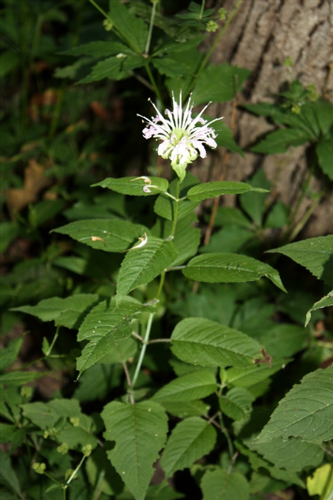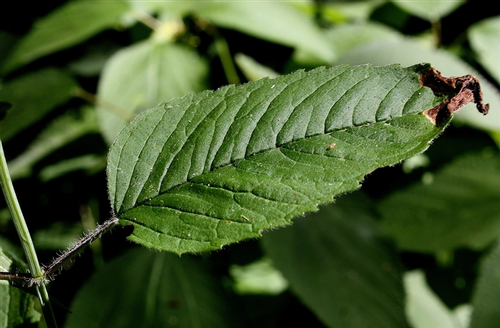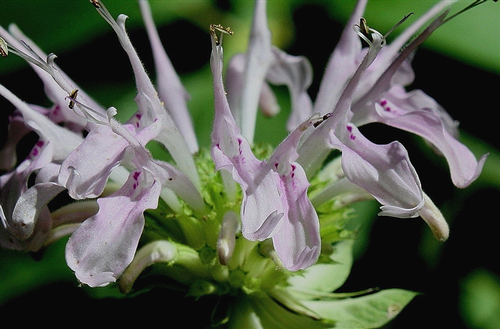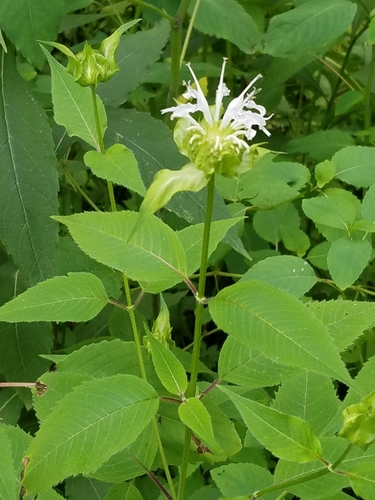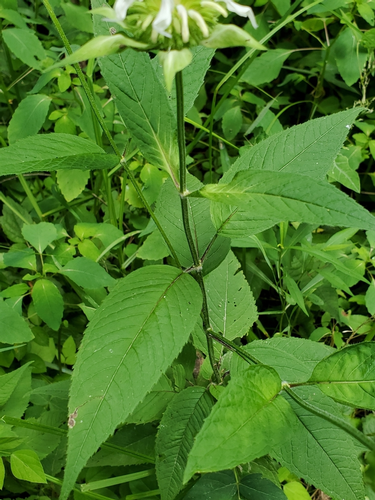Plants and Animals
Monarda clinopodia White bergamot
Key Characteristics
White bergamot has a perennial herb that is 75–90 cm (2.5–3 ft) tall and has a square stem, opposite leaves, two-lipped flowers (i.e. bilabiate) and a distinctive basil or mint-like smell when crushed. Leaves are simple, 6.5–11 cm (2.5–4.3 in) long with serrate margins and sparse hairs on both surfaces and on the petioles. Flowerheads are terminal and composed of 15–20 flowers that are usually whitened but rarely purple-pink at the base. The upper lip lacks hair, and the lower lip usually exhibits purple spotting.
White bergamot most closely resembles wild bergamot but three characteristics distinguish the two species: white bergamot has pale flowers with a hairless (i.e., glabrous) upper lip, longer leaf petioles and a habitat preference of moist, floodplain forests.
Status and Rank
US Status: No Status/Not Listed
State Status: T - Threatened (legally protected)
Global Rank: G5 - Secure
State Rank: SNR - Not ranked
Occurrences
| County | Number of Occurrences | Year Last Observed |
|---|
Information is summarized from MNFI's database of rare species and community occurrences. Data may not reflect true distribution since much of the state has not been thoroughly surveyed.
Habitat
Information regarding white bergamot’s habitat in Michigan is limited, but occurrences have been documented in moist floodplain forests and similar habitats, such as wet-mesic flatwoods, and southern hardwood swamps (Reznicek et. al. 2011).
Outside of Michigan, white bergamot occurs along moist, wooded slopes and seepage bluffs near rivers as well as rich, mesic forests, ravines, and bottomlands.
Natural Community Types
For each species, lists of natural communities were derived from review of the nearly 6,500 element occurrences in the MNFI database, in addition to herbarium label data for some taxa. In most cases, at least one specimen record exists for each listed natural community. For certain taxa, especially poorly collected or extirpated species of prairie and savanna habitats, natural community lists were derived from inferences from collection sites and habitat preferences in immediately adjacent states (particularly Indiana and Illinois). Natural communities are not listed for those species documented only from altered or ruderal habitats in Michigan, especially for taxa that occur in a variety of habitats outside of the state.
Natural communities are not listed in order of frequency of occurrence, but are rather derived from the full set of natural communities, organized by Ecological Group. In many cases, the general habitat descriptions should provide greater clarity and direction to the surveyor. In future versions of the Rare Species Explorer, we hope to incorporate natural community fidelity ranks for each taxon.
Associated Plants
Maples (Acer spp.), blue-beech (Carpinus caroliniana), shagbark hickory (Carya ovata), stoneroot (Collinsonia canadensis), wild geranium (Geranium maculatum), dame's rocket (Hesperis matronalis), wood nettle (Laportea canadensis), Michigan lily (Lilium michiganense), fringed loosestrife (Lysimachia ciliata), common blackberry (Rubus allegheniensis), bloodroot (Sanguinaria canadensis), goldenrod (Solidago spp.),?common trillium (Trillium grandiflorum), and slippery elm (Ulmus rubra).
Management Recommendations
A status survey for this species is warranted to better understand its extent in Michigan. This species requires partial shade and moist soil conditios. Natural hydrologic regimes should be maintatined to protect this species. Any forest management that results in opening of the canopy or soil disturbance should be avoided to protect this species. Control invasive species and limit use of herbicides to fall after this species has senesced.
Survey Methods
Random meander search covers areas that appear likely to have rare taxa, based on habitat and the judgment of the investigator.
-
Meander Search
-
Survey Period: From first week of May to second week of July
-
References
Survey References
- Elzinga, C.L., D.W. Salzer, and J.W. Willoughby. 1998. Measuring and Monitoring Plant Populations. The Nature Conservancy and Bureau of Land Management, Denver. BLM Technical Reference 1730-1. 477pp.
- Goff, G.F., G.A. Dawson, and J.J. Rochow. 1982. Site examination for Threatened and Endangered plant species. Environmental Management 6(4): 307-316
- Nelson, J.R. 1984. Rare Plant Field Survey Guidelines. In: J.P. Smith and R. York. Inventory of rare and endangered vascular plants of California. 3rd Ed. California Native Plant Society, Berkeley. 174pp.
- Nelson, J.R. 1986. Rare Plant Surveys: Techniques For Impact Assessment. Natural Areas Journal 5(3):18-30.
- Nelson, J.R. 1987. Rare Plant Surveys: Techniques for Impact Assessment. In: Conservation and management of rare and endangered plants. Ed. T.S. Elias. California Native Plant Society, Sacramento. 8pp.
Technical References
- Gray, A., and M. L. Fernald. 1950. Gray’s Manual of Botany. 8th ed. American Book Company, New York, New York.
- NatureServe. 2023. NatureServe Network Biodiversity Location Data accessed through NatureServe Explorer Web. <https://explorer.natureserve.org/>. Accessed 3 March, 2025.
- New York Natural Heritage Program (NYNHP). 2025. Online Conservation Guide for?Monarda clinopodia. Available from: https://guides.nynhp.org/basilbalm/. Accessed September 15, 2025.
- Ortiz-Mendoza, N., M. J. Martínez-Gordillo, E. Martínez-Ambriz, F. A. Basurto-Peña, M. E. González-Trujano, and E. Aguirre-Hernández. 2023. Ethnobotanical, Phytochemical, and Pharmacological Properties of the Subfamily Nepetoideae (Lamiaceae) in Inflammatory Diseases. Plants 12: 1-22.
- Peana, A. T., P.S. D’Aquila, F. Panin, G. Serra, P. Pippia, and M. D. L. Moretti. 2002. Anti-inflammatory Activity of Linalool and Linalyl Acetate Constituents of Essential Oils. Phytomedicine 9: 721-726.
- Prather, L. A., A. K. Monfils, A. L. Posto, and R. A. Williams. 2002. Monophyly and Phylogeny of Monarda (Lamiaceae): Evidence from the Internal Transcribed Spacer (ITS) Region of Nuclear Ribosomal DNA. Systematic Botany 27(1): 127-137.
- Reznicek, A. A., E. G. Voss, and B. S. Walters. 2011. Michigan Flora Online. University of Michigan. Web. <https://michiganflora.net/>. Accessed 31 March 2025.
- Scora, R.W. 1964. Interspecific Relationships in the Genus Monarda (Labiatae). Dissertation, the University of Michigan, Ann Arbor, U.S.A.
- Stevens, P. F. 2017. Angiosperm Phylogeny Website, Version 14. <www.mobot.org/mobot/research/apweb/>. Accessed 31 March 2025.
- U.S.A., Michigan. Lenawee County, 2017. Prather, A. (MSC [MSC0256469]).
- Whitten, W. M. 1981. Pollination Ecology of Monarda didyma, M. clinopodia, and Hybrids (Lamiaceae) in the Southern Appalachian Mountains. American Journal of Botany 68(3): 435-442.
- Wilhelm, G. and L. Rericha. 2017. Flora of the Chicago Region: A Floristic and Ecological Synthesis. Indiana Academy of Science, Indianapolis, IN.


